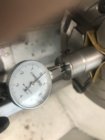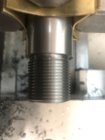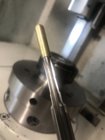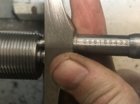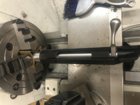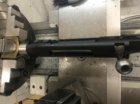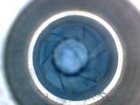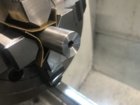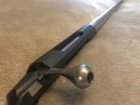AllThingsAI
Silver $$ Contributor
Profiling Barrel Blank:
I have to admit, I’m not a huge fan of profiling barrels from a blank. I’d much rather just purchase a previously profiled barrel and head straight for the fun stuff, but beggars can’t be choosers. I got a good deal on a Stainless .257”, 1:10, 27”, 1.200” OD Blank from Green Mountain and thought I’d give it a go.
The first step in my process is to align the barrel through the headstock of my lathe. I managed to align within a few tenths. I then cut a temporary tenon on the breach side of the barrel. This will later become the barrel shank, but for now it’s oversized and gives me a good surface to put in my collet chuck. I also reverse the barrel and cut a 60 degree chamfer on the muzzle end to locate my tailstock live center. Temporary tenon below:
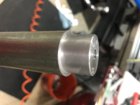
With my precision collet chuck driving the barrel, I also set up my live center and a steady rest to help eliminate chatter. Chatter is always a problem with long unsupported spans and I’ve found that if I work by cutting towards the tail stock my system stays more ridged and I get less/no chatter.
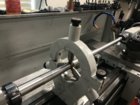
For this barrel profile I needed to be at a final Od of 1.125” at the breach and 0.875” at the 26” mark. Being my own CNC what happens between these points is what I call “artistic license”...aka good luck! I shot for the first 4” or so to be at full diameter then tapering down to 1” OD at around the 7” mark. From there to the end it’s pretty much a straight taper to the final 26” diameter of 0.875”.
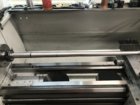
I run a few passes along the entire barrel more or less roughing out the shape. For my final contour I mark out the barrel with sharpie and calculate the depth of cut change rate I need to make on the cross slide for a given feed speed along the barrel. As I engage the auto feed I turn the cross slide at approx the rate I calculated for that given section....it’s hard to gauge and not always accurate. This is why I call it “artistic license”! Hard to focus on turning that dial with sweat pouring into your eyes!
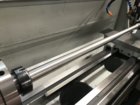
All things considered it turned out pretty nice. Kinda like my pancake batter....only a few lumps! But certainly nothing a file, sandpaper, scotch brite, and some elbow grease won’t fix!
I have to admit, I’m not a huge fan of profiling barrels from a blank. I’d much rather just purchase a previously profiled barrel and head straight for the fun stuff, but beggars can’t be choosers. I got a good deal on a Stainless .257”, 1:10, 27”, 1.200” OD Blank from Green Mountain and thought I’d give it a go.
The first step in my process is to align the barrel through the headstock of my lathe. I managed to align within a few tenths. I then cut a temporary tenon on the breach side of the barrel. This will later become the barrel shank, but for now it’s oversized and gives me a good surface to put in my collet chuck. I also reverse the barrel and cut a 60 degree chamfer on the muzzle end to locate my tailstock live center. Temporary tenon below:

With my precision collet chuck driving the barrel, I also set up my live center and a steady rest to help eliminate chatter. Chatter is always a problem with long unsupported spans and I’ve found that if I work by cutting towards the tail stock my system stays more ridged and I get less/no chatter.

For this barrel profile I needed to be at a final Od of 1.125” at the breach and 0.875” at the 26” mark. Being my own CNC what happens between these points is what I call “artistic license”...aka good luck! I shot for the first 4” or so to be at full diameter then tapering down to 1” OD at around the 7” mark. From there to the end it’s pretty much a straight taper to the final 26” diameter of 0.875”.

I run a few passes along the entire barrel more or less roughing out the shape. For my final contour I mark out the barrel with sharpie and calculate the depth of cut change rate I need to make on the cross slide for a given feed speed along the barrel. As I engage the auto feed I turn the cross slide at approx the rate I calculated for that given section....it’s hard to gauge and not always accurate. This is why I call it “artistic license”! Hard to focus on turning that dial with sweat pouring into your eyes!

All things considered it turned out pretty nice. Kinda like my pancake batter....only a few lumps! But certainly nothing a file, sandpaper, scotch brite, and some elbow grease won’t fix!










